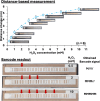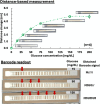Development of a Semiquantitative Barcode Readout Approach for Paper-Based Analytical Devices (PADs) for Enzymatic H2O2 and Glucose Detection
- PMID: 39791888
- PMCID: PMC11780576
- DOI: 10.1021/acs.analchem.4c04113
Development of a Semiquantitative Barcode Readout Approach for Paper-Based Analytical Devices (PADs) for Enzymatic H2O2 and Glucose Detection
Abstract
The integration of barcode technology with smartphones on paper-based analytical devices (PADs) presents a promising approach to bridging manual detection with digital interpretation and data storage. However, previous studies of 1D barcode approaches have been limited to providing only a "yes/no" response for analyte detection. Herein, a method of using barcode readout for semiquantitative signal detection on PADs has been achieved through the integration of barcode technology with a distance-based measurement concept on PADs. To demonstrate the feasibility of this concept, a PAD fabrication strategy incorporating barcodes was explored, using the enzymatic reaction between horseradish peroxidase (HRP), 3,3'-diaminobenzidine (DAB), and H2O2 as a model system. The enzyme-catalyzed polymerization of DAB to polyDAB in the presence of hydrogen peroxide results in the appearance of color observable by the naked eye inside a paperfluidic channel, with the color-changed length depending on the H2O2 concentration. At the same time, the barcode pattern displayed as a result of this distance-based color evolution overlaid with a paper-based barcode layer can be read using a smartphone application. Parameters affecting the signal readout performance were studied. The developed device can be used to detect H2O2 concentrations in the range of 0.25 to 10 mM within 90 min with 79.6% of barcode signals correctly readable. Additionally, results from different smartphone models showed a consistent reading performance (78.4-79.6%). Finally, the quantification of glucose levels in artificial urine samples was demonstrated. This developed PAD signaling strategy offers end-users more simplicity and can be used as a standalone device or in conjunction with other digital devices.
Conflict of interest statement
The authors declare no competing financial interest.
Figures




Similar articles
-
A single nanoparticle-based real-time monitoring of biocatalytic progress and detection of hydrogen peroxide.Talanta. 2018 Aug 1;185:581-585. doi: 10.1016/j.talanta.2018.04.032. Epub 2018 Apr 10. Talanta. 2018. PMID: 29759244
-
3,3'-diaminobenzidine (DAB)-H2O2-HRP voltammetric enzyme-linked immunoassay for the detection of carcionembryonic antigen.Bioelectrochemistry. 2008 Feb;72(1):47-52. doi: 10.1016/j.bioelechem.2007.11.011. Epub 2007 Dec 3. Bioelectrochemistry. 2008. PMID: 18248855
-
All-printed semiquantitative paper-based analytical devices relying on QR code array readout.Analyst. 2020 Sep 14;145(18):6071-6078. doi: 10.1039/d0an00955e. Analyst. 2020. PMID: 32812544
-
A gold nanomaterial-integrated distance-based analytical device for uric acid quantification in human urine samples.Analyst. 2024 Nov 4;149(22):5518-5526. doi: 10.1039/d4an01139b. Analyst. 2024. PMID: 39420824
-
NFC-enabled photothermal-based microfluidic paper analytical device for glucose detection.Analyst. 2024 Jul 8;149(14):3756-3764. doi: 10.1039/d4an00506f. Analyst. 2024. PMID: 38837236
References
-
- Manmana Y.; Kubo T.; Otsuka K. Recent Developments of Point-of-Care (POC) Testing Platform for Biomolecules. TrAC Trends Anal. Chem. 2021, 135, 116160.10.1016/j.trac.2020.116160. - DOI
MeSH terms
Substances
LinkOut - more resources
Full Text Sources

